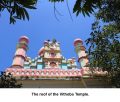Knowing Temple Architecture- The Finial

Temples are architectural marvels. They have attracted world wide attention and appreciation as well as invasions from outside invaders in the past. During the partition days they were the target of destruction and demolition. The lack of understanding between the two communities is more because the Hindus themselves have forgotten the symbolic meaning behind architecture of their temple marvels. Knowing the meaning will remove many misgivings between the two major religious communities of the world. Today, the average Hindu made them a place of worship only and paid little attention to the serious aspects of their creations. The first thing to be remembered is that a Hindu temple like other places of worship is not a simple prayer hall. It has been a place of learning for different schools of philosophies.
Following elements of its architecture impress, instantly, at the very first view:
1- A tapering form, a dome at the top and a finial above it.
2- The animal and human figures on the plate-form and figures of deities displayed, all over, on the backside of the temple, up to the top.
3- A dome resembling Buddhist Stupa in temples of Nagara style in the North India and a barrel shaped Buddhist Chaitya in the Dravida style temples of South India.
4- The Icons of many small temples gradually converging towards a single large size dome at the top, in the Shikherni style of temple, and most importantly
5- A finial consisting of Aamalaka-inverted lotus, a golden pot- the Purna ghata and a coconut- Bija puraka, over it.
For the purpose of the present dispatch, I will discuss only the last two elements .
The truth of the temple stays at the top- the structure of the finial. In Nagara as well Dravida style Hindu temples upon the dome in the finial rests a golden pot (Ghatam) with a coconut (Bijapuraka) above it attracting every one even from a long distance. The pot- Purna-ghatam is perfection symbolized. It is made of gold signifying purity and the power to emanate light. Om purnam idam. The structure represents the wholeness and the state of spiritual fulfillment.
Only a person having attained the state of purity of gold and spiritual fulfillment of one’s consciousness can give light to others. This is the state attained by the Sadgurus or Sufi Masters. Even gods struggling for the perfection do not reach this state. About such a perfect man Hafiz the Sufi perfect master says, which Meherbaba translates as following-
Hafiz is afraid that he will be drowned in the divine ocean, due to this intoxication that is in his head tonight.
The experience happened to Vivekananda in a similar situation and the perfect master Shree Ramkrishna had to say ‘your time is still not ripe my dear’. Such is the state of Majoob-e- kamil or the Sadguru, who alone has the power to emanate light to the universe.
The coconut on top of the Ghatam, is the latent power of creation resting with the Sadgurus, but which they do not ever display. A coconut has three structural constituent layers. The outermost is a tough coat resembling Bhuh –the Matter. Middle layer of edible soft pulp-the Energy or Bhuvah and the container with coconut milk– the mind and consciousness– the Svah. Over the coat, there are three eyes– representing the state of Tryambaka -the Shiva.
Whenever, a disciple approaches a master, he offers an unbroken coconut. By this act, he conveys the request, to open for him the gates of knowledge of all the three worlds (The Bhurbhuvah svah). In temples the coconut is broken in front of the deities. The act, symbolizes the perfect surrender by the devotee of his faculties of matter, mind and energy, at the feet of the lord.
Coconut also symbolizes the three gunas. The tiny embryo inside is the future seed of creation. It means that the game of desires is over and there is end of the spiritual journey of the individual soul, the one who has reached the state of Nirvikalpa or Fana-fillah, yet he keeps alive with him, the future possibilities of creation. During any puja in Hindu homes a pot or Ghatam, with a coconut over the mouth, is always kept for the ritual.
When the soul is fully satiated and is in the state of perfect rest, peace and fulfillment, it is Fana-fillah. A Sufi term for the original divine state of absolute vacuum, which is equivalent to Nirvikalpa State of Vedanta, writes Meherbaba. The Purna ghatam at the top in the finial represents this. The Fana-fillah is a goal of spiritual journey, where “I am God” state is experienced, by those persons who are called “Majzoobs”, also known as Brahmi bhoots in Vedanta (God Speaks. p.129).
There is another Sufi term Fana–baqa, which means perfections of different planes, before reaching the final state of Fana-fillah. It represents the many little individual perfections of spiritual path. In Hindu temples they are shown as chains of many small temples which converge upward towards a single point at the top, where all idols disappear. The Ghatam symbolizes the state of Sthita Prajnya, which is described as one of equipoise and perfection. Reaching the state, the man is not disturbed by any kind of the desires as well as emotions. The empty space of mind is filled by the peace and love, which are not the attributes of mind, but of soul.
Lotus symbolizes the evolutionary emergence or creation. It is self alone which creates itself, through the gradual self emergence. The lotus opens through the gradual opening of the enfoldments, symbolizing evolution. A lotus motif stands for evolution rather than instant creation. It opens during the mornings and closes at the nights, symbolizing the act of awakening and sleeping of God Vishnu. Thus, lotus being creation, the icon on lotus inside the temples, symbolizes coming of the lord in the creation.
During the act of creation, God manifests in of creative forms and patterns. If open, the lotus means creation, the inverted lotus means dissolution, the end of Maya –the illusion. Thus at the top of the dome at the finial stays an inverted Lotus. In the upward spiritual journey, the inverted lotus means the end of all desires and therefore all the play of Maya. It symbolizes Manonasha -the perfect annihilation of Mind –The Fana.
The dome form, reached Hindu architecture via Buddhist Stupa. The Hindu finial reached the architecture of Muslim mosques and dargahs throughout the sub -continent and even to the architecture of middle-east. The finial of Hindu architecture is one where Islam meets Hinduism in the corridors of the temple in the script readable to both the communities, in the concept of the finial. A study is yet required in the variation of the finial-motif. It will further enlighten us of the idea as it traveled thus far. No community can close the flow of ideas and human relationships. India, the oldest religious community must own the responsibility and make the break through now.
-
Book Shelf
-
 Book Review
DESTINY OF A DYSFUNCTIONAL NUCLEAR STATE
Book Review
DESTINY OF A DYSFUNCTIONAL NUCLEAR STATE
- Book ReviewChina FO Presser Where is the fountainhead of jihad?
- Book ReviewNews Pak Syndrome bedevils Indo-Bangla ties
- Book Review Understanding Vedic Equality….: Book Review
- Book Review Buddhism Made Easy: Book Review
- Book ReviewNews Elegant Summary Of Krishnamurti’s teachings
- Book Review Review: Perspectives: The Timeless Way of Wisdom
- Book ReviewNews Rituals too a world of Rhythm
- Book Review Marx After Marxism
- Book Review John Updike’s Terrorist – a review
-
-
Recent Top Post
- Commentaries Record Pentagon spending bill and America’s hidden nuclear rearmament
-
 CommentariesNews
Ides of trade between India and Pakistan
CommentariesNews
Ides of trade between India and Pakistan
-
 Commentaries
How sustainable is the rhetoric of India-China Bhai-Bhai
Commentaries
How sustainable is the rhetoric of India-China Bhai-Bhai
-
 CommentariesTop Story
New Set of Diplomatic Strains with Canada
CommentariesTop Story
New Set of Diplomatic Strains with Canada
-
 News
Ratan Tata’s Legacy
News
Ratan Tata’s Legacy
-
 Commentaries
India’s Strategic Push on the World Stage
Commentaries
India’s Strategic Push on the World Stage
- Commentaries Veils of Resistance
- Commentaries Ensuring Safety for Women Healthcare Workers
-
 CommentariesTop Story
Palestinians at the cross- roads
CommentariesTop Story
Palestinians at the cross- roads
-
 CommentariesTop Story
While Modi professes concern for the jobless, “his government’s budget escalates class war”
CommentariesTop Story
While Modi professes concern for the jobless, “his government’s budget escalates class war”
AdSense code
















